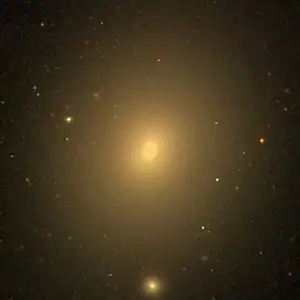NGC 4261
NGC 4261 ist eine elliptische Galaxie mit aktivem Galaxienkern vom Hubble-Typ E2 im Sternbild Jungfrau auf der Ekliptik. Sie ist schätzungsweise 95 Millionen Lichtjahre von der Milchstraße entfernt und hat einen Durchmesser von etwa 120.000 Lichtjahren. Die Galaxie ist unter der Katalognummer VCC 345 als Mitglied des Virgo-Galaxienhaufens gelistet.

| Galaxie Daten von NGC 4261 | |
|---|---|
 | |
| NGC 4261 mit LEDA 39660 (u)[2] (SDSS) | |
| AladinLite | |
| Sternbild | Jungfrau |
| Position Äquinoktium: J2000.0, Epoche: J2000.0 | |
| Rektaszension | 12h 19m 23,2s[3] |
| Deklination | +05° 49′ 31″[3] |
| Erscheinungsbild | |
| Morphologischer Typ | E2-3 / LINER / Sy3[3][4] |
| Helligkeit (visuell) | 10,4 mag[4] |
| Helligkeit (B-Band) | 11,4 mag[4] |
| Winkelausdehnung | 4,1′ × 3,6′[4] |
| Positionswinkel | 160°[4] |
| Flächenhelligkeit | 13,4 mag/arcmin²[4] |
| Physikalische Daten | |
| Zugehörigkeit | Virgo-Cluster NGC 4261-Gruppe WBL 392 LGG 278[3][5] |
| Rotverschiebung | 0.007378 ± 0.000017[3] |
| Radialgeschwindigkeit | 2212 ± 5 km/s[3] |
| Hubbledistanz vrad / H0 |
(95 ± 7) · 106 Lj (29,2 ± 2,0) Mpc [3][6] |
| Geschichte | |
| Entdeckung | William Herschel |
| Entdeckungsdatum | 13. April 1784 |
| Katalogbezeichnungen | |
| NGC 4261 • UGC 7360 • PGC 39659 • CGCG 042-013 • MCG +01-31-052 • 2MASX J12192326+0549289 • VCC 345 • GC 2842 • H II 139 • h 1176 • GALEXASC J121923.25+054929.9 • LDCE 904 NED041 • EVCC 342 | |
NGC 4261 besitzt bipolare Jets, die radioastronomisch beobachtet werden, und die weit über die im optischen Spektralbereich erkennbare elliptische Struktur hinausgehen. Im Zentrum der Galaxie befindet sich eine Akkretionsscheibe, die mithilfe des Hubble-Weltraumteleskops entdeckt wurde, und die auf ein zentrales Schwarzes Loch mit 5·108 Sonnenmassen hindeutet – die hundertfache Masse des Schwarzen Lochs im Zentrum der Milchstraße.[7]
Im selben Himmelsareal befinden sich u. a. die Galaxien NGC 4257, NGC 4264, NGC 4269, IC 3155.
Die Typ-Ia-Supernova SN 2001A wurde hier beobachtet.[8]
Das Objekt wurde am 13. April 1784 von William Herschel entdeckt.[9]
Weblinks
- SIMBAD Astronomical Database
- Hubble-Weltraumteleskop 1995
- Hubble-Weltraumteleskop 1992
- Chandra
- The Heart Of NGC 4261 – Astronomy Picture of the Day vom 7. November 1999 (englisch).
Einzelnachweise
- Aladin Lite
- Aladin Lite
- NASA/IPAC EXTRAGALACTIC DATABASE
- SEDS: NGC 4261
- VizieR
- Richard Nolthenius: A revised catalog of CfA1 galaxy groups in the Virgo/Great Attractor flow field. In: Astrophysical Journal Supplement Series. 85, no. 1, 1993, S. 1–25. bibcode:1993ApJS...85....1N. doi:10.1086/191753. Joseph B.Jensen, John L. Tonry, Brian J. Barris, Rodger I. Thompson, Michael C. Liu, Marcia J. Rieke, Edward A. Ajhar, John P. Blakeslee: Measuring Distances and Probing the Unresolved Stellar Populations of Galaxies Using Infrared Surface Brightness Fluctuations. In: Astrophysical Journal. 583, Nr. 2, Februar 2003, S. 712–726. arxiv:astro-ph/0210129. bibcode:2003ApJ...583..712J. doi:10.1086/345430.
- Laura Ferrarese, Holland C. Ford, Walter Jaffe: Evidence for a Massive Black Hole in the Active Galaxy NGC 4261 from Hubble Space Telescope Images and Spectra. In: Astrophysical Journal. 470, 1996, S. 444. bibcode:1996ApJ...470..444F. doi:10.1086/177876.
- Simbad
- Seligman
